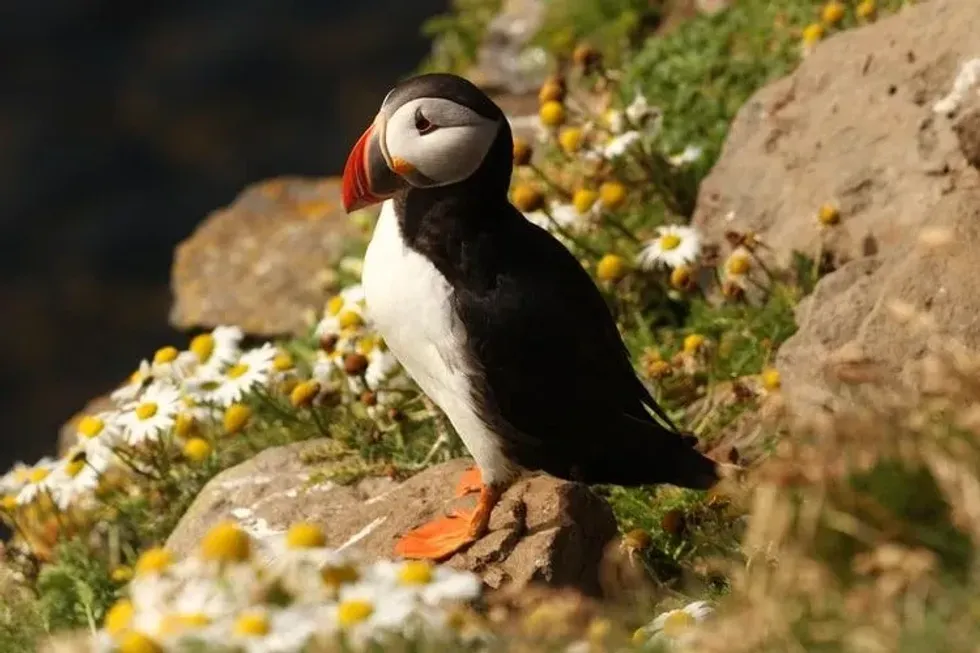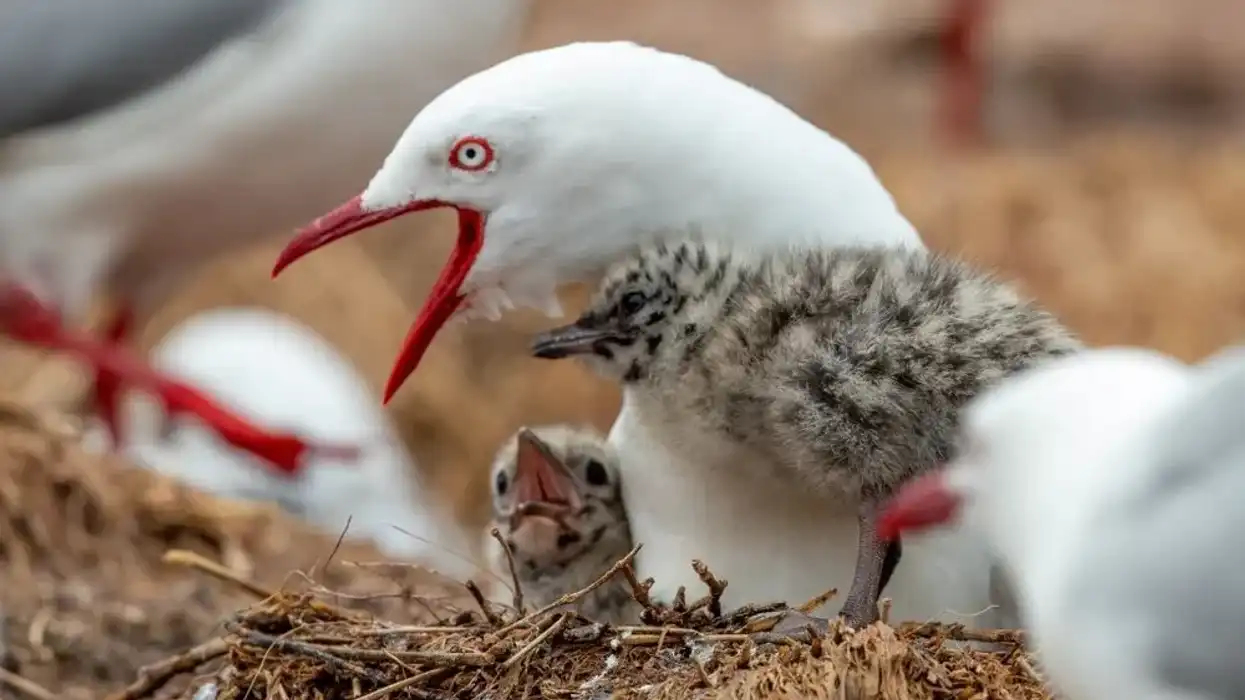Atlantic puffin (Fratercula arctica), popularly known as common puffins, are the birds of North Atlantic waters. During winter, they explore the sea by flying to many places over water.
In summer, the Atlantic Puffin breeds in their nest or burrows that they make with the help of their beaks and feet deep into the ground. Their breeding colonies are present in Iceland, Newfoundland and Labrad0or, eastern Britain, Norway.
Among these places, the highest population of these birds is found in Iceland. In water, Atlantic puffins use their wings as propellers.
In summer, these birds go swimming while feeding on small fishes such as herring and sand eels in the water. These birds make their nest or burrow in such lands that are typically predator-free, possessing no threat to them.
Atlantic puffins act as food to some species of wild gull and a few other birds of similar size. Therefore to save themselves from their attacks, puffins make deep burrows with their beaks and claws on cliff tops where they keep themselves and their babies safe.
If you want to gather more interesting knowledge about this free-spirited bird, then here are some fascinating facts about Atlantic Puffins and how they lead their life.
Atlantic Puffin Interesting Facts
What type of animal is a Atlantic puffin?
Atlantic puffins are seabirds that belong to the auk family.
What class of animal does a Atlantic puffin belong to?
Atlantic puffins belong to the class Aves.
How many Atlantic puffins are there in the world?
At present, it can be estimated that around four to five million pairs of Atlantic puffins are present, Iceland being the home to around 60% of the entire population.
Where does a Atlantic puffin live?
Atlantic puffins reside in an extensive range covering some of the islands of the North Atlantic Ocean, both in North America and in Europe. In Europe, these birds nest in the countries of Iceland, Quebec, Norway, Greenland, some parts of Britain, and in the western parts of Russia.
Atlantic Puffins are also found in the North American colonies of Newfoundland and Labrador and in some north-eastern parts of the United States. However, more than half the populations reside in Iceland.
What is a Atlantic puffin's habitat?
Atlantic Puffin habitat is commonly found on the rocky cliffs of the North Atlantic Ocean during their breeding season that lasts from April to August. They form burrows as their nests on the ground by using their beak and use their sharp claws and webbed feet to scrap the unwanted soil and live in those burrows or nests.
Their breeding colonies are present on the top of rocky cliffs which are bordered by feathers and grass. During the non-breeding season, they fly freely over the open ocean.
Who do Atlantic puffin live with?
Atlantic puffins live on the open ocean for the most part of the year. They come to the coasts during the spring-time when their breeding season starts.
During the time of returning from the oceans, these birds prefer to live in groups that consist of thousands of birds. After returning to their nest or burrow, Atlantic puffins usually stay with a single mate for years and return to the same burrow.
How long does a Atlantic puffin live?
On average, puffins can live for nearly two decades. The recorded age of the oldest puffin is believed to have lived till 36 years old. The exact age of puffins could not be determined by researchers due to the difficulties they face in gaining data due to the living habits of Atlantic puffins.
How do they reproduce?
Atlantic puffins breed once they turn five. They are considered to be monogamous (they mate for life), and both parents take good care of their egg or the young chick after it hatches.
The female birds generally lay a single egg at a time, but if the egg is lost somehow, they might lay another one in that particular season, and both the parents take part in incubating the egg by taking turns until it hatches.
What is their conservation status?
This species of seabirds fall under the group of vulnerable species rated by IUCN. Their conservation is threatened, and the visibility of Atlantic puffins has steeply fallen in many colonies where they were seen in large numbers once, especially in Maine.
This is because, in Maine, there was over-hunting of Atlantic puffins for feathers and food. By 1900, all the colonies of Maine were free of Atlantic puffins except two.
Atlantic Puffin Fun Facts
What do Atlantic puffin look like?

Atlantic puffins have a black and white coat that somewhat resembles the body of a penguin. Starting from the crown to the portion where the back ends, they have black feathers.
The feathers in the front part of the body, like the chest and the belly, are white in color. The body color being very basic, they flaunt a vibrant red and black beak and orange feet.
During the winter, when they fly over the sea, these seabirds moult (shed a part of their body), due to which some colored portions of the body get lost. These parts reappear again in the spring-time.
Their face also has grey patches around the cheek area, which is light grey in color for adults, and dark grey, in the case of a chick.
Chicks have a slightly narrow bill of dark grey and yellowish-brown color, and they miss the ornamentation of the head. Both the breeds appear to be identical.
However, the males are slightly longer in size. The northern puffins are larger than the ones in the south.
How cute are they?
Atlantic puffins appear quite cute due to their pudgy stature. They have a very small structure and have a round body shape which makes them look like a ball of feathers from a distance, especially when two birds are together in a flight.
How do they communicate?
In most situations, puffins use body movements to communicate with their mates. When they come to the island to breed, Atlantic Puffins rub their beaks with their respective mates, which are called billing.
During a time of the fight, they communicate aggressively by gaping, a process of puffing up the feathers to appear larger in size. They also spread their wings and opens their bill. The wider they open their beak, the more aggressive the bird gets.
Sometimes they stomp their feet to communicate their displeasure. The walking style of a puffin also plays a major role in communication.
How big is a Atlantic puffin?
An Atlantic puffin is generally 10-12 in (28- 30 cm) in height which is around two times smaller than a horned puffin.
How fast can a Atlantic puffin fly?
This bird can fly quite fast. Their speed range from 48-55 mph (77-88 km/hr). For flying faster, the bird flaps its wings as fast it can in order to gain speed. They can flap their wings 400 times in a minute.
How much does a Atlantic puffin weigh?
The average weight of an Atlantic puffin is 0.9-1.4 lb (400-650 g).
What are their male and female names of the species?
The species of puffins do not have particular names for female or male birds. However, Atlantic puffins are also called common puffins, and they have trivial nicknames such as 'sea parrot' and the 'clown of the sea'.
What would you call a baby Atlantic puffin?
Baby Atlantic puffins are commonly called chicks. But more appropriately, Baby puffins are known as pufflings.
What do they eat?
Puffins explore the sea in winter and settle on islands in the spring season. As a result, their diet mainly constitutes fish.
On examining a puffin's stomach, traces of shrimps, mollusks, and some worms are also found. An adult Atlantic puffin is required to consume 40 small fishes likes herring, capelin, sprat, and sand eels in a day. They dive with speed in the water to find a fish and flies away very fast.
Are they dangerous?
Atlantic puffins do not possess any dangerous traits. They have a more or less friendly attitude that does not hurt anybody. They are rather curious about humans. Overall, this seabird seems to have a cool temperament and less aggressive than other birds.
Would they make a good pet?
Petting Atlantic puffins is certainly illegal in North American countries like the United States and Canada. In these parts, they come under special legislation. This is done mainly to protect them from man-made threats. However, even if you are allowed to pet these birds, they cannot be tamed properly. They lack disciplinary behaviors and cannot be trusted as pets.
Did you know...
The beak of a puffin changes color during different seasons of the year. More interestingly, these seabirds rest for most of their life on waves.
The Atlantic puffin's survival techniques
Atlantic puffins are at the least threat when they are at sea during the winter. Here, seals and some large fishes try to kill them, but puffins make their colonies on the island to prevent their common predators.
The most potential threat that Atlantic puffins possess is aerial. Birds like herring gulls, black-backed gulls, the great skua, and some other birds of similar size prey on them while in flight.
When a puffin detects such danger, they dive towards the ground or go inside their burrows. If they somehow fall prey to these birds, puffins use their bill and sharp claws to protect themselves.
Symbolism of the Atlantic puffin
The Atlantic puffin is seen as a symbol of self-empowerment. This bird-guide will always encourage us to find the right direction in our life and become successful in the future by letting go of the past. The fighting spirit of these birds is truly inspirational.
Here at Kidadl, we have carefully created lots of interesting family-friendly animal facts for everyone You can even occupy yourself at home by drawing one on our Atlantic puffin coloring pages.









